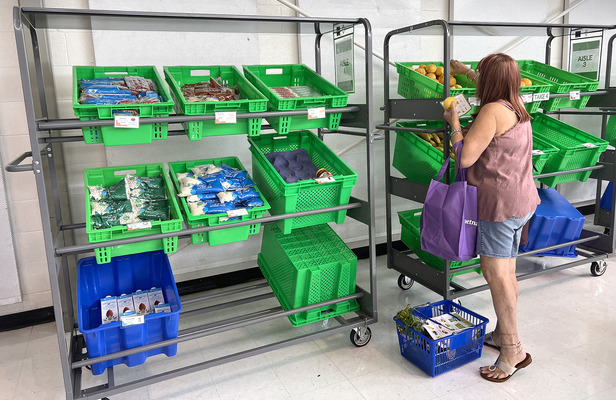
A platform that encourages healthy conversation, spiritual support, growth and fellowship

NOLACatholic Parenting Podcast
A natural progression of our weekly column in the Clarion Herald and blog

The best in Catholic news and inspiration - wherever you are!
New Second Harvest hunger stats troubling
-

By Macie Capote
Clarion Herald
Second Harvest Food Bank, an affiliated ministry of the Archdiocese of New Orleans, revealed on May 15 that a shocking one in seven – or 16.9% of Louisianans – is at risk of hunger. The highest rate of child food insecurity, which affects one in three children, is found in Orleans Parish at 31.8%.These hunger numbers aren’t improving. According to Second Harvest Food Bank CEO Natalie Jayroe, the regional food bank that serves the 23 parishes of south Louisiana is experiencing the most challenging year yet.
Chronic poverty, unlivable wages and inflation are just a few factors that keep New Orleans at the top of the list for food insecurity.
“People can’t afford to live here,” Jayroe said. “You may see that a living wage in Louisiana is $12 an hour, but no one in New Orleans can live on $12 an hour.”
According to the U.S. Census Bureau, since 2020, New Orleans has experienced the largest population decline of any metropolitan area in the U.S.
Jayroe said Second Harvest expected things to ease off a little for these families after the COVID-19 pandemic, but food insecurity seems to have only worsened. With COVID benefits gone and attempts to limit the amount of benefits available for families and individuals under the Supplemental Nutrition Assistance Program (SNAP, families are facing poverty at a much higher rate.
“Low-income people are struggling more than ever, even more than they were prior to the pandemic,” Jayroe said. “Inflation picked up where COVID left off.”
Second Harvest is experiencing double-digit increases in people asking for help and to be connected to benefits such as SNAP.
Jayroe believes the increased risks can be attributed to increased costs, while wages are not keeping up.
“People have gone through their savings,” she said. “Folks are struggling, and we’re seeing it.”
Second Harvest’s Summer Feeding and Kids’ Cafe programs have nearly tripled in size as a way to combat these rising statistics, according to Jayroe. She said they’re projecting to provide more than 7,500 meals and snacks a day and will be driving to 82 different locations throughout south Louisiana this summer.
“We started with a couple hundred thousand meals a year; we’re now well over a million meals a year out of our kitchens,” she said.
Since 2010, Second Harvest has operated out of three kitchens throughout south Louisiana; one in New Orleans, one in Vermilion Parish, and the other in Lake Charles, with a particular focus on vulnerable populations, such as seniors and children.
“Summer is always a really tough time; 15 to 20% of children that may receive school breakfast and lunch aren’t getting any kind of nutritional support during the summer,” Jayroe said. “We knew that these statistics were going to show that the number of food-insecure children was growing.”
Jayroe said she is thrilled that state officials were able to change Gov. Landry’s administration’s decision to not accept $71 million in additional federal food benefits for children.
“People were just very frightened about what they were going to do,” she said. “That’s $40 per child, $120 per family for children who are eligible for free and reduced breakfast and lunch.”
The funds are accepted from the Summer Electronic Benefits Transfer (EBT) program and will be put on a card that is spent in the family’s local grocery store.
“Not only does it add benefit to the families, but it also benefits these grocery stores that are struggling,” she said.
Second Harvest, in serving the entirety of south Louisiana, has also seen many rural grocery stores close down.
“They’re dealing with the same inflationary pressures that these families are dealing with,” Jayroe said.
Despite grocery stores going out of business due to inflation, Second Harvest recently launched their Makin’ Groceries Mobile Market, which is a grocery store on wheels that provides fresh produce to “food deserts” that don’t have access to affordable nutrition.
Jayroe said that the mobile market is already making a huge impact on these food deserts and families facing poverty and food insecurity.
To view Feed America’s map of food insecurity among the overall population in the Second Harvest Food Bank of Greater New Orleans and Acadiana service area, go to https://bit.ly/3ysTlZ6.




